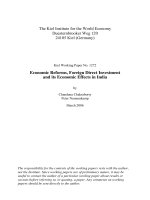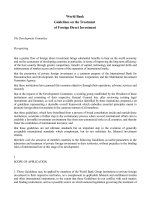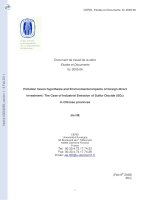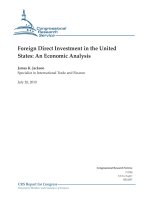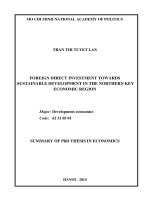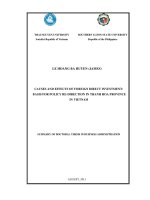Outward foreign direct investment in ASEAN
Bạn đang xem bản rút gọn của tài liệu. Xem và tải ngay bản đầy đủ của tài liệu tại đây (3.69 MB, 250 trang )
Outward Foreign
Direct Investment
in ASEAN
The ISEAS – Yusof Ishak Institute (formerly Institute of Southeast
Asian Studies) was established as an autonomous organization in 1968.
It is a regional centre dedicated to the study of socio-political, security
and economic trends and developments in Southeast Asia and its
wider geostrategic and economic environment. The Institute’s research
programmes are the Regional Economic Studies (RES, including ASEAN
and APEC), Regional Strategic and Political Studies (RSPS), and Regional
Social and Cultural Studies (RSCS).
ISEAS Publishing, an established academic press, has issued more
than 2,000 books and journals. It is the largest scholarly publisher of
research about Southeast Asia from within the region. ISEAS Publishing
works with many other academic and trade publishers and distributors
to disseminate important research and analyses from and about Southeast
Asia to the rest of the world.
First published in Singapore in 2017 by
ISEAS Publishing
30 Heng Mui Keng Terrace
Singapore 119614
E-mail:
Website: <>
All rights reserved. No part of this publication may be reproduced, stored in a
retrieval system, or transmitted in any form or by any means, electronic, mechanical,
photocopying, recording or otherwise, without the prior permission of the
ISEAS – Yusof Ishak Institute.
© 2017 ISEAS – Yusof Ishak Institute, Singapore
The responsibility for facts and opinions in this publication rests exclusively with the
author and his interpretations do not necessarily reflect the views or the policy of the
publisher or its supporters.
ISEAS Library Cataloguing-in-Publication Data
Outward Foreign Direct Investment in ASEAN / edited by Cassey Lee and
Sineenat Sermcheep.
1. Investments, Foreign—Southeast Asia.
2. Investments, Southeast Asian.
I. Lee, Cassey.
II. Sineenat Sermcheep.
HG5740.8 O93
2017
ISBN 978-981-47-6240-3 (soft cover)
ISBN 978-981-47-6241-0 (e-book, PDF)
Typeset by Superskill Graphics Pte Ltd
Printed in Singapore by Markono Print Media Pte Ltd
CONTENTS
List of Tablesvii
List of Figuresx
Foreword by Suthipand Chirathivatxiii
About the Contributorsxv
Introduction1
Cassey Lee and Sineenat Sermcheep
1.
The Rise of Outward Foreign Direct Investment from ASEAN
Sineenat Sermcheep
5
2.
ASEAN’s Outward Foreign Direct Investment
Aekapol Chongvilaivan and Jayant Menon
3.
The Impact of the ASEAN Economic Community on
Outward FDI in ASEAN Countries
Pitchaya Sirivunnabood
4.
Determinants of Singapore’s Outward FDI
Cassey Lee, Chew Ging Lee and Michael Yeo
5.
Outward Foreign Direct Investment from Malaysia
Tham Siew Yean, Teo Yen Nee and Andrew Kam Jia Yi
103
6.
Indonesia’s Outward Foreign Direct Investment
Maxensius Tri Sambodo
128
30
47
79
Contents
vi
7.
Factors Influencing Thailand’s Outward FDI
Kornkarun Cheewatrakoolpong and Panutat Satchachai
152
8.
Outward Foreign Direct Investment: The Case of Vietnam
Hoang Thi Thu
180
9.
Myanmar as a Destination for OFDI: A New ASEAN Foreign
Investment Frontier
Jean-Pierre A. Verbiest and Tin Htoo Naing
Index
202
227
LIST OF TABLES
1.1
1.2
ASEAN FDI Outflows, 1980–2013
Selected Top 20 Sources of OFDI in Asia, 2014
2.1
Rankings of Top TNCs from ASEAN by Foreign
Assets, 2012
Top Sovereign Wealth Funds (SWFs) of Developing
Asia, Ranked by the Value of Assets, 2007
Distribution of Outward FDI Stock by Economic
Sector and Industry, 2000, 2008
Country Rankings by Outward FDI Performance
Index, 2000–07
2.2
2.3
2.4
3.1
3.2
3.3
3.4
3.5
3.6
3.7
4.1
4.2
4.3
Mechanisms of the Impacts of Regional Economic
Integration on FDI
Relative Bilateral FDI Intensity of Selected ASEAN
Countries as Home Economies, 2012
ASEAN’s Key Investment Efforts
Assessment of ASEAN+1 FTAs
FDI Flows of Each AMS to ASEAN
Flows of Intra-ASEAN FDI in 2013
Outward FDI Flows from ASEAN, annual average
6
6
35
38
41
43
50
52
60
62
64
65
66
ASEAN Country Share of Singaporean OFDI Stock,
1997–201287
Singapore’s OFDI by Sector, 2012
88
Sectoral Composition of Singapore’s OFDI for
Main Destination Countries, 2012
89
List of Tables
viii
4.4
4.5
Determinants of OFDI Stock — Arellano-Bond
Dynamic Panel-Data Estimation
Determinants of OFDI Flow — Arellano-Bond
Dynamic Panel-Data Estimation
94
96
5.1
5.2
Description of Variables
Regression Results
118
120
6.1
6.2
6.3
Inward and Outward FDI Stock for Selected Countries
OFDI from Indonesia in Singapore by Major Industry
Remittance and Number of Indonesian Migrants
in 2013
Incentives for ASEAN Countries — Presidential
Regulation No. 39 Year 2014
141
142
6.4
7.1
7.2
7.3
7.4
7.5
7.6
7.7
8.1
8.2
8.3
8.4
8.5
8.6
8.7
Thailand’s Outward FDI Flows during 2009–14,
by Sectors
Thailand’s Outward FDI Flows in Manufacturing
Sub-Sectors during 2009–14
Summarized Data Sources
Descriptive Statistics for the Case of ASEAN-5
Descriptive Statistics for the Case of CLMV
Estimation Results for ASEAN-5
Panel Regression of Equation (1) in Case of CLMV
143
148
156
158
162
163
163
164
167
Structure of GDP in Vietnam
184
Annual Average Value and Ratio per GDP of
Major Factors
185
Vietnam’s Outward FDI
192
Structure of Outward FDI of Vietnam by Sector,
1989–2013193
Vietnam’s Outward FDI by Economic Activity,
1989–2013194
Structure of Outward FDI of Vietnam by Region
196
Top 10 Destination of Outward FDI of Vietnam,
1989–2013197
List of Tablesix
9.1
9.2
9.3
9.4
Cumulative Foreign Direct Investment in Myanmar
by Sector (up to 31 March 2011)
Cumulative Foreign Direct Investment in Myanmar
by Country (up to 31 March 2011)
Yearly Approved Foreign Investment by Sector
Yearly Approved Foreign Investment by Country
208
210
212
213
LIST OF FIGURES
1.1
1.2
1.3
1.4
1.5
1.6
1.7
2.1
2.2
2.3
2.4
2.5
3.1
3.2
3.3
Outward FDI Flows from Selected ASEAN
Countries, 2010–13
ASEAN Inward and Outward FDI Flows, 1980–2013
ASEAN Countries’ Inward and Outward FDI
Flows, 1980–2013
Geographical Distribution of Outward FDI Stock,
as of 2012
Sectoral Distribution of Intra-ASEAN Investment
in 2013
Outward FDI Flows from ASEAN, China,
Hong Kong, Taiwan and Korea, 1980–2013
China, Hong Kong, Korea and Taiwan Inward
and Outward FDI Flows, 1980–2013
7
12
14
17
19
24
25
Outward FDI Flows from ASEAN, 1990–2013
Intra-ASEAN FDI, 2005–14
Outward FDI Stock by ASEAN Country, 1990–2013
Value of Cross-border M&As by Purchasers from
ASEAN Countries, 1990–2013
Value of Greenfield FDI Projects by Sources from
ASEAN Countries, 2003–13
32
33
36
ASEAN’s Inward FDI Trend, 1995–2013
Top 10 Investors in ASEAN, 2012–13
ASEAN’s Outward FDI, 2003–13
53
54
55
37
38
List of Figuresxi
3.4
3.5
3.6
3.7
3.8
ASEAN’s Outward Foreign Direct Investment Trends,
2000–1366
ASEAN’s Outward FDI, by Destination, 2001–12
69
Starting Up a Foreign Business in ASEAN, 2014
71
Barriers to Business Expansion in Southeast Asia
73
Critical Business Expansion Enablers in ASEAN
73
4.1
4.2
4.3
4.4
4.5
Singapore’s Investment Abroad
Composition of Singapore’s Investment Abroad
Singapore’s OFDI Flow
OFDI Flow as a Percentage of GDP
Main OFDI Stock Country Destinations
5.1
Malaysia’s Inward FDI and Outward FDI by Flows
and Stocks, 1980–2013
Stocks of Outward FDI by Top 10 Countries, 2003–13
Malaysia’s Stock of Outward FDI by Top 5 Countries
Sectors, 2003–13
Stocks of Outward FDI by Sector, 2003
Compared with 2013
Investment Income Repatriation (Credit) from
Direct Investment, 2005–13
5.2
5.3
5.4
5.5
6.1
6.2
6.3
6.4
6.5
6.6
6.7
7.1
Inward and Outward Foreign Direct Investment
of Indonesia
Number of Companies in Top 100 Non-financial
TNCs from Developing and Transition Economies,
Ranked by Foreign Assets, 2012
Inward FDI Flow
Indonesia’s Investment Development Path
Stock of Direct Investment Abroad from Indonesia
Indonesia’s Greenfield OFDI
Indonesia’s FDI Stock Abroad, by Geographical
Destination (in 2012)
Thailand’s FDI Stocks, 2001–13
83
84
85
85
86
105
107
107
109
110
129
131
133
134
137
138
140
155
List of Figures
xii
7.2
Thailand’s Outward FDI in Textile Industry in
ASEAN and CLMV
169
8.1
8.2
Economic Growths in Vietnam, 1986–2013
Trend of Vietnam’s Outward FDI, 1989–2013
183
191
9.1
Approved Foreign Direct Investment, Annual Foreign
Direct Investment Inflows and Total Investment
206
FOREWORD
Outward foreign direct investment (OFDI) from developing countries has
been growing significantly since the turn of the century. According to a
recent study by UNCTAD, the share of developing country’s outward FDI
to global outflows has increased from 11.79 per cent in 2000 to 33.79 per
cent in 2014. These growing outflows are driven by an increase in capital
and trade openness from globalization and economic integration, and an
increase in participation in international production networks.
ASEAN, a group of mostly developing countries in Southeast Asia,
has, in between times, played an active role in international investment.
Many ASEAN countries are already destinations of FDI from the developed
economies. More recently, some of these countries have adjusted their own
positions from being net capital inflow countries to become net capital
outflow countries. Today, the obvious major investors from ASEAN are
Singapore, Malaysia, and Thailand — collectively generating 79.54 per
cent of outward FDI from ASEAN in 2014. With the advent of the ASEAN
Economic Community (AEC) in 2016 and beyond, these net capital outflows
from ASEAN to other destinations will continue to expand.
As a matter of fact, outward FDI from ASEAN countries is only at the
beginning stage, so there is no wonder why literature on the topic is still
very limited. To understand the integrated picture of outward FDI and
to foresee the potential future of outward FDI in ASEAN, an overview of
outward FDI in the region as well as the role of AEC should be examined.
By bringing in the experiences from each country, as major investors or
as major recipients of FDI, and the new players in the region will help
to contribute to a more complete and integrated picture of international
investment in ASEAN.
For this reason, ASEAN Studies Center and the Faculty of Economics,
Chulalongkorn University and ISEAS – Yusof Ishak Institute jointly
xiv
Foreword
cooperated in this book project. The objectives of this book are to: (1) discuss
the development of outward FDI in ASEAN; (2) examine the potential
impact of AEC on outward FDI in ASEAN; and (3) discuss the experiences of
the major investors from ASEAN (Singapore, Malaysia, Thailand), potential
investors (Vietnam and Indonesia) and a major recipient of FDI (Myanmar).
The seminar for the book project was organized with the cooperation of
all parties concerned. Finally, we would like to thank the editors, chapter
writers and the secretariat support staff from both institutions.
Suthiphand Chirathivat
Executive Director, ASEAN Studies Center, Chulalongkorn University
ABOUT THE CONTRIBUTORS
Kornkarun Cheewatrakoolpong is an Associate Professor at the Faculty
of Economics, Chulalongkorn University, Bangkok. She is a coordinator of
“The study of Thailand’s outward FDI”, sponsored by Thailand Research
Fund (TRF). She publishes “Trade Diversification and Crisis Transmission:
A Case Study of Thailand” in Asian Economic Journal and “Trade linkages
and crisis spillovers” in Asian Economic Papers. She also has several
published papers, chapters of edited volumes and journal articles. Her
current work concentrates on trade facilitation, production networks,
and FDI.
Aekapol Chongvilaivan is a Country Economist for the Philippines at
Asian Development Bank (ADB). He undertakes economic analysis and
assessments of ADB’s operations in the Philippines and provides technical
advice to the Government on its macroeconomic management and
structural reforms, and helps facilitate necessary capacity development.
Prior to joining ADB, he was Fellow at the Institute of Southeast Asian
Studies in Singapore (now known as the ISEAS – Yusof Ishak Institute).
He holds a PhD in Economics from the National University of Singapore.
He has published in several academic journals such as Economic Inquiry,
Labour Economics, British Journal of Industrial Relations, and Social Indicators
Research.
Cassey Lee is a Senior Fellow at the ISEAS – Yusof Ishak Institute, Singapore.
Dr Lee has held academic appointments at the University of Wollongong,
Australia, University of Nottingham Malaysia Campus and University of
Malaya. Dr Lee received his PhD from University of California, Irvine.
He is currently the managing editor for the Journal of Southeast Asian
Economies.
xvi
About the Contributors
Lee Chew Ging is the Dean and Professor of Quantitative Methods at
Faculty of Social Sciences, University of Nottingham Malaysia Campus.
His research papers have been published in peer reviewed journals such
as Applied Economics, Journal of Sport Economics, Journal of International
Development, International Journal of Tourism Research, Tourism Management
and International Journal of Hospitality Management.
Jayant Menon, PhD is Lead Economist in the Economic Research
Department at the Asian Development Bank in Manila, Philippines. He
holds adjunct appointments with the Australian National University and
the University of Nottingham. He is the author or co-author of more than
one hundred academic publications, mostly on trade and development,
and particularly as they relate to Asia.
Tin Htoo Naing is a researcher at the Center for Economy, Environment
and Society (CEES Myanmar) and a visiting lecturer in development
economics at Yangon Institute of Economics. He holds a PhD in Economic
Policy, Growth and Inequality from University of Malaya, Malaysia. He was
an International Research Associate at Asia-Europe Institute, University
of Malaya, Malaysia, a Senior Policy Advisor for the Garman Agency for
International Cooperation, Myanmar, and a Research Fellow at University
of Turin in Italy. As an economist, he possesses sound knowledge and
broad experience of providing advisory services for economic policymaking, law-drafting and evaluating projects in Myanmar and works
as an Economic Policy Advisor to international institutions. He was also
deeply involved in many research areas related to macroeconomic policy,
economic integration, inequality and poverty alleviation, agricultural and
industrial development and published papers in journals, project reports
and international conferences.
Teo Yen Nee is a PhD candidate at the Institute of Malaysian and
International Studies, the National University of Malaysia. She graduated
with a Bachelor of Arts double majored in Economics and History at the
National University of Malaysia, and Msc. Economics from the same
university.
Maxensius Tri Sambodo is a Senior Researcher at the Indonesian Institute
of Sciences (LIPI) — Economic Research Center. He is also a visiting fellow
alumni from the Institute of Southeast Asian Studies (ISEAS), Singapore.
About the Contributorsxvii
His research interests are on economic development, energy, environment,
and natural resources. He obtained a bachelor degree in Economics
from Padjadjaran University, Indonesia; masters in International and
Development Economic from the Australian National University; and PhD
in Public Policy from the National Graduate Institute for Policy Studies
(GRIPS), Japan. His latest articles appeared in ASEAN Energy Market
Integration (AEMI): From Coordination to Integration (2013) and Government
and Communities: Sharing Indonesia’s Common Goals (2014), and his latest
book From Darkness to Light: Energy Security Assessment in Indonesia’s Power
Sector is published by ISEAS – Yusof Ishak Institute in 2016.
Panutat Satchachai is an Assistant Professor in Economics, and currently
is the Associate Dean taking care of research affairs at the Faculty of
Economics at Chulalongkorn University. His research interests are in
econometrics and international finance, especially the modelling for foreign
direct investments. His other research projects include the economic issues
on border trade and investment in the CLMV countries.
Sineenat Sermcheep is an Associate Dean at the Faculty of Economics and
the Director of Research Affairs at ASEAN Studies Center, Chulalongkorn
University, Thailand. She has a PhD in Economics from the University of
Utah and is currently an Assistant Professor in Economics. She mainly
undertakes research related to foreign direct investment, economic
integration and ASEAN. Her other areas of interest include trade in services
and economic development.
Pitchaya Sirivunnabood, PhD in Economics, is an Assistant Director of
Financial Integration Division, ASEAN Economic Community Department,
ASEAN Secretariat. Her expertise is in the areas of international economics
and finance, specializing in regional economic integration and financial
cooperation as well as bilateral and multilateral free trade agreements,
development of financial markets, and international/transnational
investments. Previously, as the Senior Economist at the ASEAN Integration
Monitoring Office, ASEAN Secretariat, she was also in charge of monitoring
the progress of the ASEAN Economic Community (AEC), including other
related regional economic surveillance mechanisms.
Hoang Thi Thu is Associate Professor in Economics and Dean of the Faculty
of Banking and Finance at the Thainguyen University of Economics and
xviii
About the Contributors
Business Administration in Vietnam. She holds an MA in Economics from
University of Hawaii at Manoa and received her PhD in Economics from
Chulalongkorn University, Bangkok. Her research interests include foreign
direct investment, economic growth and financial management in Vietnam.
Jean-Pierre A. Verbiest is a senior economist based in Southeast Asia since
over thirty years. He holds a BA in economics and finance from FUCAM
in Mons (Belgium), an MSc in Econometrics from the Universite Libre
de Bruxelles (ULB, Belgium) and a doctorate in economics from Oxford
University (UK). He joined the United Nations Commission for Asia and the
Pacific (UNESCAP) in Bangkok, Thailand in 1981 as a research economist,
moving to the Economic Research Department of the Asian Development
Bank (ADB) in Manila, the Philippines, in 1989. He held several senior
positions in the ADB including Manager, Strategy and Policy Department,
Assistant Chief Economist (Macro-economics and Finance) and Country
Director in Viet Nam (1996–2000) and Thailand (2005–10). In 2011–12, he
was principal consultant (ASEAN 2030 study) for the Asian Development
Bank Institute (ADBI, Tokyo) and in 2013–14 he was lead consultant/team
leader for the ADB’s Economic Research Department diagnostic study on
Myanmar. He is Policy Advisor, Mekong Institute, and a partner in West
Indochina Inc. His principal research interests are macroeconomic policies
in East and Southeast Asian countries, economic reforms in Myanmar
and regional economic and financial cooperation and integration in Asia.
Tham Siew Yean is a Senior Fellow at the ISEAS – Yusof Ishak Institute,
Singapore and Adjunct Professor at Institute of Malaysian and International
Studies (IKMAS), Universiti Kebangsaan Malaysia. She was formerly
Director and Professor at IKMAS, Universiti Kebangsaan Malaysia. She has
served as a consultant to national agencies in Malaysia and international
agencies, including the World Bank, Asian Development Bank, and Asian
Development Bank Institute. She has also published extensively on foreign
direct investment, international trade in goods and services, trade policies,
and industrial development in Malaysia and ASEAN. She has a PhD in
Economics from the University of Rochester, USA.
Michael Yeo is a Research Associate at the ISEAS – Yusof Ishak Institute,
Singapore. Michael was educated at the SOAS University of London and the
London School of Economics. An economic historian, Michael is currently
pursuing his doctoral studies at the University of Oxford.
About the Contributorsxix
Andrew Kam Jia Yi is a Research Fellow at the Institute of Malaysian and
International Studies, the National University of Malaysia. He graduated
First Class in BSc Economics specializing in Econometrics at the National
University of Malaysia, MSc Economics from Warwick University, UK and
PhD from the Australian National University (ANU). He was the recipient
of the Chevening Scholarship in 2005, Australian Endeavour Postgraduate
in 2008 and the 2014–15 Malaysian Fulbright Scholarship programme.
His research interests include international trade, industrialization and
economic growth.
INTRODUCTION
Cassey Lee and Sineenat Sermcheep
Southeast Asian countries have historically engaged in international
trade long before the arrival of European colonial powers in the sixteenth
century. The prospects and potential gains from trade and the control of
the sources of natural commodities attracted these powers and eventually
led to the colonization of much of Southeast Asia. With the exception of
Thailand, which was never colonized by any European power, much of
Southeast Asia became further integrated with the global economy as
foreign colonies. In the aftermath of the Second World War, countries
in the region gained independence and with it, sought to develop their
economies via export-oriented industrialization. This did not take place
simultaneously and concurrently amongst countries in the region. Political
and institutional differences meant that some countries (such as Malaysia,
Singapore, Thailand and Indonesia) had an earlier headstart than others
(such as Cambodia, Laos, Myanmar and Vietnam). As a result, there are
still large differences in the level of development amongst countries in the
region. This continues to be a significant challenge for member countries
of the Association of Southeast Asian Nations (ASEAN) as they seek to
achieve higher levels of regional economic integration.
One important manifestation of the differences in the level of
development amongst ASEAN member countries is the difference in
the patterns of foreign direct investment (FDI). At the initial stage of
development, most ASEAN countries have abundant labour but lacked
capital and technology. For ASEAN countries that adopted the exportoriented industrialization strategy early, the inflow of foreign direct
2
Cassey Lee and Sineenat Sermcheep
investment (inward FDI) into the export-oriented industries in the
manufacturing sector helped overcome these limitations. Over time, as
higher levels of development and income per capita were attained, the
factor composition in these more developed ASEAN countries began to tilt
towards greater capital intensity and higher technology. At this juncture,
enterprises in these countries, both local and foreign-owned, began seeking
countries abroad to invest in — with the hope of establishing production
facilities and/or accessing the final markets in these countries. The result
is the emergence of outward FDI (OFDI) from the more developed ASEAN
countries. The above transformation has been observed amongst ASEAN
countries. Singapore, Malaysia and more recently Thailand has become
net-investors in which outward FDI exceeded inward FDI.
Despite the increasing importance of OFDI in ASEAN countries,
relatively little research has been published on the topic. The goal of this
book is to rectify this research and literature gap. This is achieved by
examining and assessing the current state of OFDI in ASEAN countries.
This is undertaken using two approaches. The first approach seeks to
analyse OFDI from a cross-country and regional (ASEAN) perspective.
The second approach looks at outward FDI from country perspectives.
BOOK COVERAGE
Cross-country and regional analyses of OFDI in the ASEAN region are
covered in the first three chapters of this volume. Sineenat Sermcheep
(Chapter 1) provides a review of the literature on OFDI as well as the
recent trends in the patterns of OFDI in ASEAN countries. The chapter
also examines the experiences of East Asian countries and draw some
important lessons for ASEAN countries. The issue of intra-ASEAN OFDI
is examined by Aekapol Chongvilaivan and Jayant Menon (Chapter 2).
The authors also identify and discuss some of the key OFDI players in the
region. The ASEAN framework and agreements for regional investment
integration is discussed in the chapter by Pitchaya Sirivunnabood
(Chapter 3). The author also discusses future challenges facing ASEAN
member countries and ASEAN (as an institution) in promoting greater
regional economic integration via intra-regional direct investments.
The country case studies on OFDI in this volume covers Singapore,
Malaysia, Indonesia, Thailand, Vietnam and Myanmar. The case of Singapore
is examined by Cassey Lee, Chew Ging Lee and Michael Yeo (Chapter 4).
Introduction
3
The authors provide a review of the Singaporean government’s policy on
OFDI and analyse the country’s OFDI trends. This is supplemented by
an econometric analysis of the drivers of the country’s OFDI. Malaysia
OFDI patterns and drivers are examined by Tham Siew Yean, Teo Yen
Nee and Andrew Kam Jia Yi (Chapter 5). Indonesia’s OFDI trends are
analysed by Maxensius Tri Sambodo (Chapter 6). In addition, the chapter
reviews the country’s OFDI in Singapore (as a country destination) and
MNE’s involvement in OFDI. Kornkarun Cheewatrakoolpong and Panutat
Satchachai (Chapter 7) review OFDI trends in Thailand and provide an
econometric analysis of the determinants of OFDI in Thailand in two groups
of ASEAN countries, namely, the ASEAN-5 and CLMV countries. The case
of Vietnam is examined by Hoang Thi Thu (Chapter 8). In her chapter, the
author traces the evolution of OFDI-related policies, regulations and laws
in Vietnam as well as OFDI trends during different periods. Myanmar
as a country destination for ASEAN OFDI is discussed by Jean-Pierre A.
Verbiest and Tin Htoo Naing (Chapter 9).
MAIN FINDINGS
The level of outward FDI flows from ASEAN countries has increased rapidly
in the past two decades despite reversals during periods of economic crises
in 1997/98 and 2008. There has been an increase in intra-ASEAN OFDI
flows particularly since 2009. As expected, there is significant diversity in
terms of the size of OFDI flows across ASEAN countries. Singapore has
been a major investor for some time. Malaysia, Thailand and Indonesia
are relatively newcomers to OFDI. More recently, OFDI from Vietnam has
also increased rapidly. OFDI flows from ASEAN countries have focused
primarily in three sectors, namely, manufacturing, financial services and
real estate.
What are the drivers of the OFDI flows in ASEAN countries? The
theoretical explanations for OFDI ranges from macro-level theories
incorporating elements from the Product Life Cycle theory to the more
micro-oriented approach by Dunning. The former charts the evolution of
production for domestic markets to production from foreign base driven
by changes in domestic input and output markets as countries become
more developed. Dunning’s theory emphasizes on ownership, locational
and internalization advantages that accrue to firms from investing abroad.
The list of OFDI drivers have also been mapped to different types of
4
Cassey Lee and Sineenat Sermcheep
FDI — market-seeking, efficiency-seeking, resource-seeking and strategic
asset-seeking. The empirical evidence documented in this volume suggest
that the drivers of OFDI differ across different industries and sectors. Key
drivers include market size, tax rates, trade cost, transport cost and trade
agreements. These results and the qualitative evidence from country case
studies point to the importance of trade and domestic policies as well as
regulations that can enhance OFDI. Finally, the prospects of OFDI in ASEAN
countries are promising, especially OFDI from more developed ASEAN
countries to less developed ASEAN countries. The rising importance of
intra-ASEAN OFDI supports this view.
1
THE RISE OF OUTWARD FOREIGN
DIRECT INVESTMENT FROM ASEAN
Sineenat Sermcheep
1. INTRODUCTION
Over the past decade, developing economies have been actively investing
abroad. This is reflected in their share of the world foreign direct investment
(FDI) outflows which increased significantly from 11.87 per cent in 2000
to a record of 35 per cent in 2014 (Table 1.1). In particular, due to the
surge in outward foreign direct investment (OFDI) from Asian developing
economies since 2005, developing Asia became the world’s largest investor
region for the first time in 2014, accounting for approximately one-third
of the global FDI outflows (UNCTAD 2015).
A number of countries from the Association of Southeast Asian Nations
(ASEAN) have become major players in the investment arena. Even though
ASEAN countries have been major recipients of FDI, they have evolved
into an emerging source of investment for many developing economies,
especially in the ASEAN region (ASEAN Secretariat 2013). The overall
FDI outflow from ASEAN rose rapidly from US$8.97 billion in 2000 to
US$56.36 billion in 2013 (Table 1.1).
Sineenat Sermcheep
6
TABLE 1.1
ASEAN FDI Outflows, 1980–2013 (in US$ million and per cent)
1980
World
Developing economies
ASEAN
% of World
% of Developing
1990
2000
2010
2012
2013
51,252 241,614 1,241,223 1,467,580 1,346,671 1,410,810
2,855 11,317 147,372 420,919 440,164 454,067
394
2,328
8,972
57,546
53,834
56,361
0.77
0.96
0.72
3.92
4.00
3.99
13.79
20.57
6.09
13.67
12.23
12.41
Source: UNCTAD.
TABLE 1.2
Selected Top 20 Sources of OFDI in Asia, 2014
Rank in 2014
12
13
10
13
17
20
Hong Kong
China
Singapore
Korea
Malaysia
Taiwan
FDI Outflows (US$ billion)
2014
2013
143
116
141
131
116
113
181
101
129
128
114
114
Growth Rate (%)
2014/2013
76.54
14.85
41.38
10.71
14.29
–7.14
Source: UNCTAD (2015).
Among the top source countries for OFDI, two leading investors from
ASEAN — Singapore and Malaysia — made it to the 10th and the 17th
rank respectively in 2014 (Table 1.2). Other major investors from East
Asia are Hong Kong, Korea, Taiwan and China. The first three have long
been leading global investors since the past few decades while China has
become the major source of OFDI recently, with a rapid rise in overseas
investment. Aside from Singapore, Malaysia and Thailand have emerged
as net investors in 2007 and 2011, respectively.
This new FDI landscape in ASEAN has been shaped by many factors
including the increase in mergers and acquisitions (M&As) and the rising
importance of the region as a key player in the global value chain. In
addition, ASEAN’s outward investment has been enhanced by regional
economic integration. The ASEAN Economic Community (AEC) aims to


